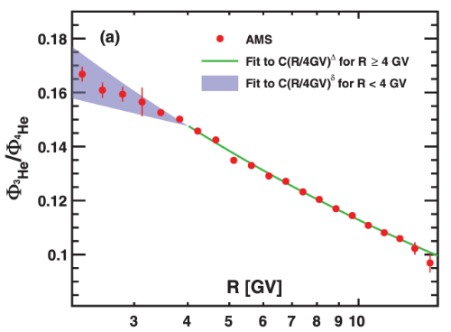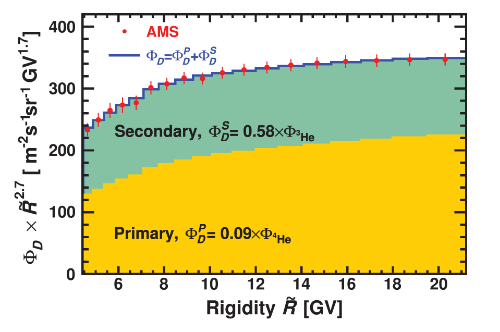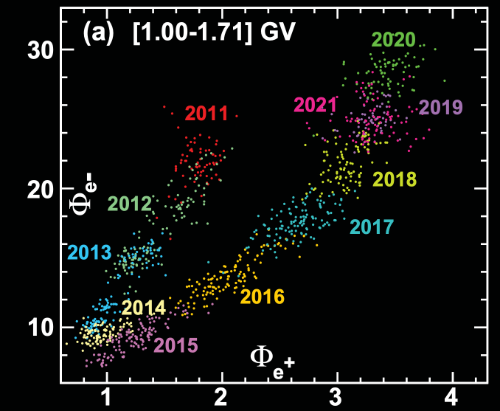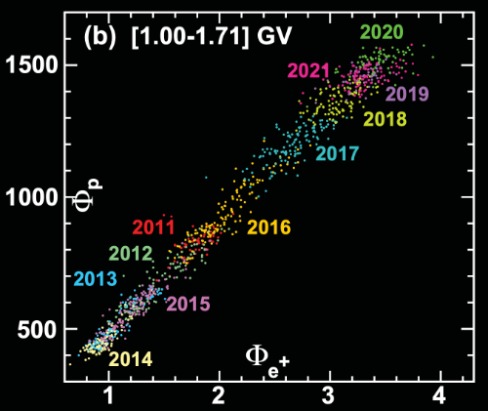Cutting-Edge Results from the AMS Experiment
Release date: 2025-05-16
Visits: 380
Source: 山东高等技术研究院
Cutting-Edge Results from the AMS Experiment
Detection on Fundamental Particles
The nature of dark matter remains unknown, and exploring the positron signals in cosmic rays is one of the important means to indirectly search for dark matter. Based on the latest in-orbit data, AMS has achieved the precise measurements of the electron and positron fluxes. The results show that most of the high-energy positron in cosmic rays come from a new source, and this positron source has a high-energy cutoff. However, the precise measurement of electron reveals that the electron flux can be explained by the superposition of two significantly different power-law spectra.
Unlike the positron, the electron flux does not have a high-energy cutoff. AMS has also carried out precise measurements of the proton and antiproton fluxes. It was found that the spectral index of the proton flux gradually increases (i.e. spectrum hardens) with the increase of the rigidity in the high-energy range, deviating from a single power-law. Moreover, the antiproton/proton flux ratio does not change with the increase of rigidity. The fluxes of antiproton, positron and proton have the same energy dependence, but the electron one is completely different. These observational results are not in line with the predictions of traditional cosmic ray models, posing new challenges to the cosmic ray theory and models.

Cosmic Ray Nuclei
Thanks to the direct detection of cosmic rays outside the Earth's atmosphere and the excellent charge resolution combining different sub-detectors, AMS has currently completed precise measurements of nuclei fluxes ranging from proton (Z=1) to silicon (Z=14), sulfur (Z=16), iron (Z=26), and so on. Primary cosmic rays are mainly produced by Stellar Nucleosynthesis, injected into the Milky Way after supernova explosions and propagate within it. AMS has discovered that there are at least two classes of primary cosmic rays with different spectrum shapes, namely the lighter helium, carbon, and oxygen class, and the heavier neon, magnesium, silicon, and sulfur class. Surprisingly, the heavier element iron, instead, has the same spectral shape as helium, carbon, and oxygen, belonging to the same class of primary cosmic rays. There are also two classes of secondary cosmic rays generated by the fragmentation of primary cosmic rays, revealing that cosmic rays with different charges and masses have distinctly different propagation characteristics. In addition, AMS has found that the energy spectra of cosmic ray nitrogen, sodium, and aluminum have both significant primary and secondary components, belonging to the third group of cosmic rays. They can be well represented by the linear combination of the primary and secondary cosmic ray fluxes measured by AMS, revealing the correlation among cosmic ray nuclei fluxes.

Cosmic Ray Isotopes
After distinguishing the types of nuclei, by combining the velocity measurements of the Time-of-Flight detector and the Ring Imaging Cherenkov detector, AMS can further measure the mass of particles to distinguish their isotope components. Since the collision cross-section of helium is smaller than that of other heavier nuclei, it can travel a longer distance within the Milky Way. Therefore, measuring the isotopes of helium is of great experimental significance for studying the propagation laws of cosmic rays over a wider range. AMS has for the first time measured the fluxes of the isotope components of cosmic ray helium as a function of rigidity, including the primary-origin 4He and the secondary 3He component mainly produced by the fragmentation of 4He during the propagation process. The result shows that the ratio of 3He to 4He above 4 GV can be described by a single power-law and does not change with solar activity.
It is generally believed that deuteron in cosmic rays belongs to secondary cosmic rays. AMS has also completed precise measurements of the fluxes of cosmic ray proton and their isotope deuteron, finding that the deuteron component in cosmic rays is significantly higher than the prediction of existing theoretical models. The excess part has the same spectral shape as 4He, indicating that the deuteron in cosmic rays has a significant primary component, which poses a new challenge to the theory of the origin of cosmic rays.


Cosmic Ray Time Dependence
Since its launch in 2011, AMS has collected cosmic ray data spanning more than a full solar activity cycle. Through precise measurements of the time evolution of fundamental particles such as electron, positron, proton, and antiproton, which have the same absolute charge but differ in charge sign or mass, AMS has discovered the "hysteresis effect" in solar modulation. Specifically, particles with the same charge but opposite signs, such as electron and proton, exhibit distinctly different temporal evolution structures. Similarly, positron and electron, which have opposite charges, show different time evolution patterns. Compared to proton, which carries the same positive charge, positron displays a similar but more pronounced temporal evolution structure, indicating a stronger influence from solar modulation.
AMS has also achieved a precise measurement of the temporal evolution of cosmic ray helium. Surprisingly, the long-term modulation effects of helium and proton fluxes show significant differences, manifesting as a "hysteresis effect" between the proton/helium flux ratio and the proton flux. Before and after 2014, the year of solar maximum, the same proton flux corresponded to two different proton/helium flux ratios. These findings are of great significance for deepening our understanding of cosmic ray propagation within the heliosphere.


The nature of dark matter remains unknown, and exploring the positron signals in cosmic rays is one of the important means to indirectly search for dark matter. Based on the latest in-orbit data, AMS has achieved the precise measurements of the electron and positron fluxes. The results show that most of the high-energy positron in cosmic rays come from a new source, and this positron source has a high-energy cutoff. However, the precise measurement of electron reveals that the electron flux can be explained by the superposition of two significantly different power-law spectra.
Unlike the positron, the electron flux does not have a high-energy cutoff. AMS has also carried out precise measurements of the proton and antiproton fluxes. It was found that the spectral index of the proton flux gradually increases (i.e. spectrum hardens) with the increase of the rigidity in the high-energy range, deviating from a single power-law. Moreover, the antiproton/proton flux ratio does not change with the increase of rigidity. The fluxes of antiproton, positron and proton have the same energy dependence, but the electron one is completely different. These observational results are not in line with the predictions of traditional cosmic ray models, posing new challenges to the cosmic ray theory and models.

Cosmic Ray Nuclei
Thanks to the direct detection of cosmic rays outside the Earth's atmosphere and the excellent charge resolution combining different sub-detectors, AMS has currently completed precise measurements of nuclei fluxes ranging from proton (Z=1) to silicon (Z=14), sulfur (Z=16), iron (Z=26), and so on. Primary cosmic rays are mainly produced by Stellar Nucleosynthesis, injected into the Milky Way after supernova explosions and propagate within it. AMS has discovered that there are at least two classes of primary cosmic rays with different spectrum shapes, namely the lighter helium, carbon, and oxygen class, and the heavier neon, magnesium, silicon, and sulfur class. Surprisingly, the heavier element iron, instead, has the same spectral shape as helium, carbon, and oxygen, belonging to the same class of primary cosmic rays. There are also two classes of secondary cosmic rays generated by the fragmentation of primary cosmic rays, revealing that cosmic rays with different charges and masses have distinctly different propagation characteristics. In addition, AMS has found that the energy spectra of cosmic ray nitrogen, sodium, and aluminum have both significant primary and secondary components, belonging to the third group of cosmic rays. They can be well represented by the linear combination of the primary and secondary cosmic ray fluxes measured by AMS, revealing the correlation among cosmic ray nuclei fluxes.

Cosmic Ray Isotopes
After distinguishing the types of nuclei, by combining the velocity measurements of the Time-of-Flight detector and the Ring Imaging Cherenkov detector, AMS can further measure the mass of particles to distinguish their isotope components. Since the collision cross-section of helium is smaller than that of other heavier nuclei, it can travel a longer distance within the Milky Way. Therefore, measuring the isotopes of helium is of great experimental significance for studying the propagation laws of cosmic rays over a wider range. AMS has for the first time measured the fluxes of the isotope components of cosmic ray helium as a function of rigidity, including the primary-origin 4He and the secondary 3He component mainly produced by the fragmentation of 4He during the propagation process. The result shows that the ratio of 3He to 4He above 4 GV can be described by a single power-law and does not change with solar activity.
It is generally believed that deuteron in cosmic rays belongs to secondary cosmic rays. AMS has also completed precise measurements of the fluxes of cosmic ray proton and their isotope deuteron, finding that the deuteron component in cosmic rays is significantly higher than the prediction of existing theoretical models. The excess part has the same spectral shape as 4He, indicating that the deuteron in cosmic rays has a significant primary component, which poses a new challenge to the theory of the origin of cosmic rays.


Since its launch in 2011, AMS has collected cosmic ray data spanning more than a full solar activity cycle. Through precise measurements of the time evolution of fundamental particles such as electron, positron, proton, and antiproton, which have the same absolute charge but differ in charge sign or mass, AMS has discovered the "hysteresis effect" in solar modulation. Specifically, particles with the same charge but opposite signs, such as electron and proton, exhibit distinctly different temporal evolution structures. Similarly, positron and electron, which have opposite charges, show different time evolution patterns. Compared to proton, which carries the same positive charge, positron displays a similar but more pronounced temporal evolution structure, indicating a stronger influence from solar modulation.
AMS has also achieved a precise measurement of the temporal evolution of cosmic ray helium. Surprisingly, the long-term modulation effects of helium and proton fluxes show significant differences, manifesting as a "hysteresis effect" between the proton/helium flux ratio and the proton flux. Before and after 2014, the year of solar maximum, the same proton flux corresponded to two different proton/helium flux ratios. These findings are of great significance for deepening our understanding of cosmic ray propagation within the heliosphere.






